Let’s be honest, marketers are constantly seeking strategies to enhance campaign performance and drive better results. One powerful tool in the marketer's arsenal is A/B testing, also known as split testing. Next to marketing analytics software it’s the most helpful tool for increasing sales growth.
In this guide, I'll cover everything from what A/B testing is and the various types of tests and implementation processes, to optimization opportunities, real-world case studies, and common mistakes to avoid. Whether you're a seasoned marketer or just starting out, this guide will help your marketing efforts pay off by driving statistically significant results.
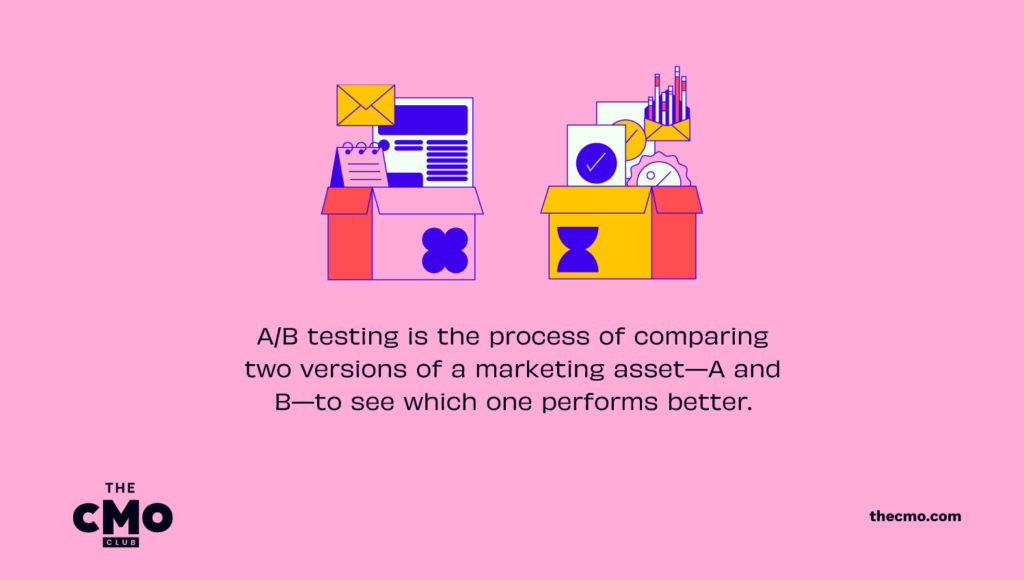
What Is A/B Testing & How Does It Work?
A/B testing is the process of comparing two versions of a marketing asset—A and B—to see which one performs better. The process involves dividing your audience into two groups and exposing each group to a different variant, then measuring the performance of each variant against a predetermined goal or metric. For example, you might test two different subject lines in an email campaign to see which one generates higher open rates.
In the context of account-based marketing (ABM), A/B testing becomes even more critical. By segmenting your target accounts and personalizing your messaging, you can tailor your A/B tests to specific audience segments, thereby creating a more positive customer experience.
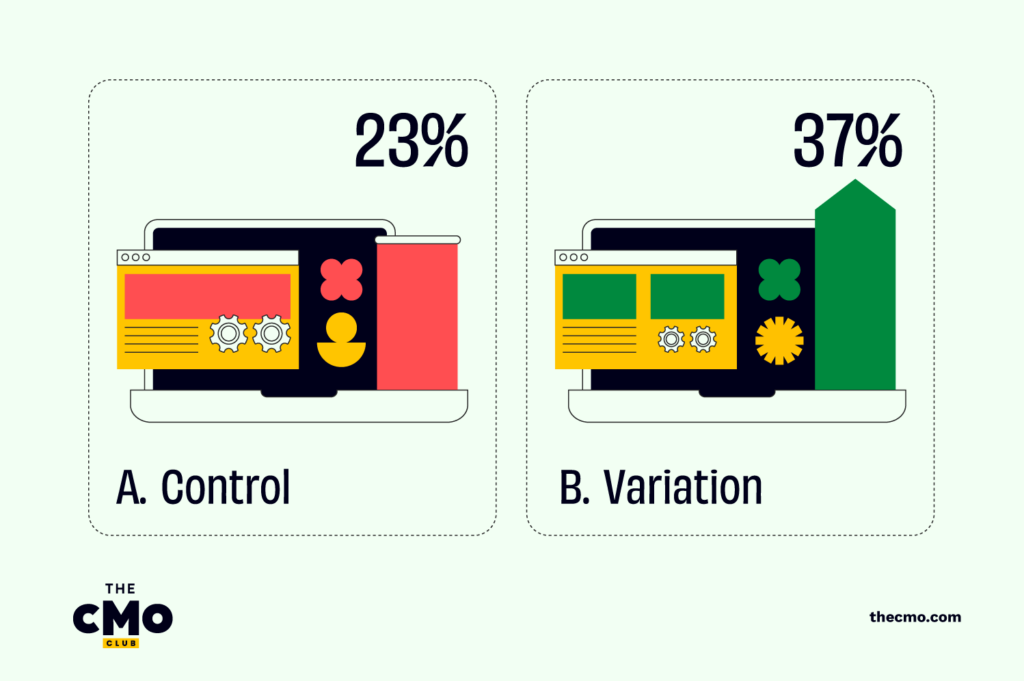
Types of A/B Tests To Know
- Multivariate Testing: allows you to test multiple variables simultaneously within a single asset, enabling you to identify the most effective combination of elements.
- Multi Page Testing: is ideal for complex sales funnels or websites with multiple pages, as it evaluates variations across multiple pages to optimize the entire user experience.
- Split URL Testing: Also known as A/B testing, split URL testing involves directing users to different URLs based on the variant they are assigned, allowing for more extensive changes to be tested.
Why Should I Use A/B Testing?
The importance of A/B testing cannot be overstated. According to Tech Report, about 60% of big companies found A/B testing helpful in increasing their growth and sales and reducing their website’s bounce rate in 2023.
The reasons for its widespread adoption are clear: A/B testing allows marketers to make informed decisions based on data rather than guesswork. By systematically testing different elements of their campaigns or new features on a website, marketers can uncover real time and valuable insights about their audience's preferences and behaviors, optimize their marketing funnel with these new insights , leading to higher engagement, conversions, and ultimately, revenue growth.
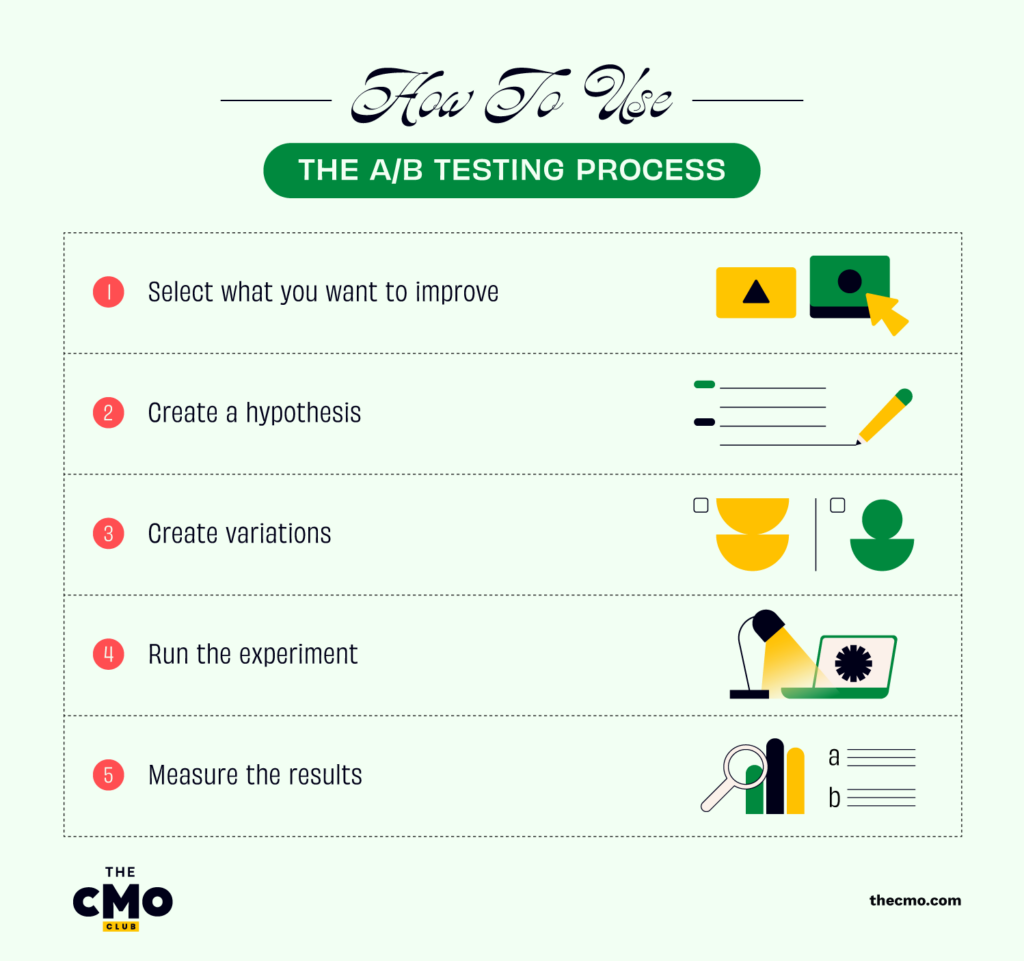
How To Use The A/B Testing Process
1. Select what you want to improve
Before diving into an A/B test, it's essential to identify the specific aspect of your marketing campaign that you want to improve. This could be anything from increasing email open and click rates to improving conversion rates on your landing page. By pinpointing the area for improvement, you can focus your efforts and measure the impact more effectively.
2. Create a hypothesis
Once you've identified the element you want to improve, it's time to formulate a test hypothesis. A hypothesis is a statement that predicts how changing a certain variable will impact your desired outcome. For example, if you're testing different email subject lines to improve open rates, your hypothesis might be: "Changing the email subject line to include a sense of urgency will increase open rates by 20%."
3. Create variations
With your hypothesis in mind, you now get to create the variations that you'll test against each other. For example, if you're testing email subject lines, you might create two different versions—one with a sense of urgency and one without. Ensure that each variation differs only in the variable you're testing, keeping all other elements constant. This allows you to isolate the impact of the variable you're testing.
4. Run the experiment
Once you've created your variations, it's time to launch your A/B test. Depending on the platform and marketing software you're using, this might involve setting up different email campaigns, creating variations of a landing page, or configuring ad campaigns with different creatives. Be sure to set up proper tracking and ensure that your test is running correctly.
5. Measure the results
After your test has been running for a sufficient amount of time to gather meaningful data (typically until you reach statistical significance), it's time to analyze the results. Compare the performance of each variation against your predetermined success metrics. For example, if you were testing email subject lines, compare the open rates of each variation to see which one performed better. Make sure to account for any external factors that may have influenced the results.
What Can I Optimize With A/B Testing?
With A/B testing, you can test changes across several components of your marketing campaigns:
- Copy: Test different web or landing page headlines, templates, body copy, and messaging to prioritize what resonates most with your audience.
- Call to Action (CTA): Experiment with different CTA button colors, wording, and placement to maximize click-through rates.
- Design and Layout: Assess the impact of different visual elements, fonts, layouts, and formatting on user engagement.
- Navigation: Test different variations of navigation structures and user flows to optimize the browsing experience from landing page to checkout.
- Forms: Optimize form fields, lengths, and layouts to improve functionality and increase form submissions.
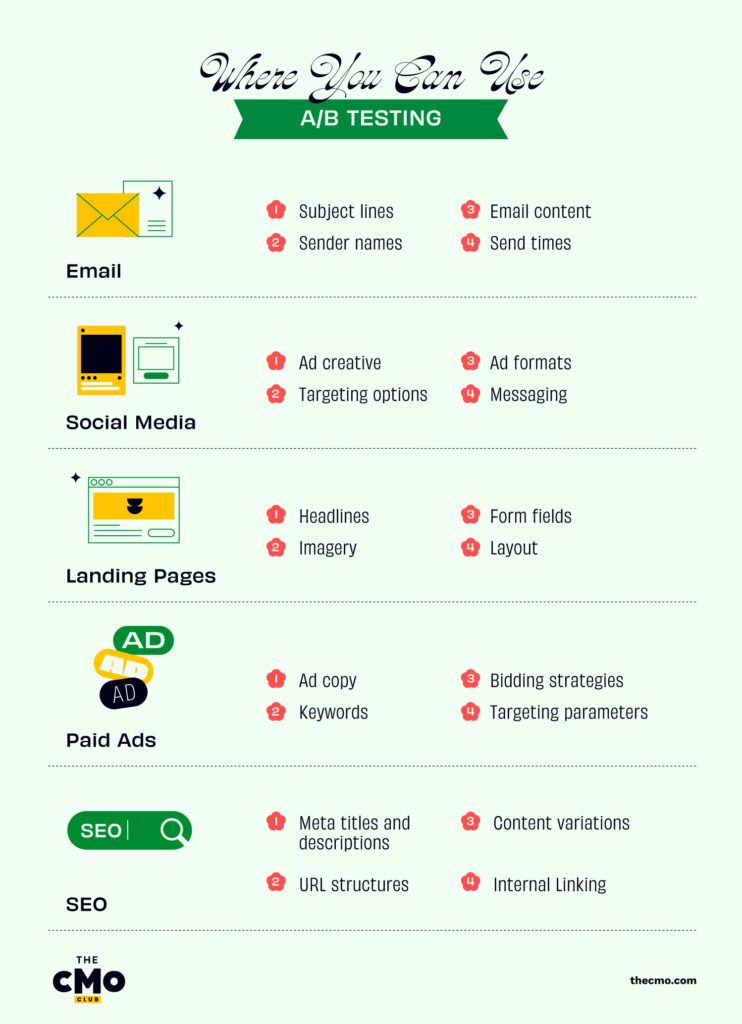
Where Can I Use A/B Testing?
To get a little more specific, here are the different channels you can use A/B testing on, plus examples of which specific components can be tested.
Email Marketing
- Subject Lines: Experiment with different lengths, tones, styles, and even emoji use to determine which ones result in higher open rates.
- Sender Names: Test different sender names or sender email addresses to see if certain variations increase trust and open rates.
- Email Content: Try different messaging, email personalization techniques, and content formats (e.g., text-only vs. HTML) to identify what resonates best with your audience.
- Send Times: Test different days of the week and times of day to find the optimal send time for maximizing open and click-through rates.
Social Media
- Ad Creative: Experiment with different images, videos, and graphics to see which ones attract the most attention and drive clicks.
- Targeting Options: Test different audience segments, demographics, interests, and behaviors to identify the most responsive audience segments.
- Ad Formats: Try different ad formats (e.g., carousel ads, video ads) to determine which ones generate the highest engagement and conversions.
- Messaging: Test different ad copy, headlines, and calls-to-action (CTAs) to see which messaging resonates best with your target audience.
Landing Pages
- Headlines: Experiment with different headline variations on your ABM landing page to see which ones capture account attention and encourage them to stay on the page.
- Imagery: Test different images, graphics, color schemes, and videos to determine which visual elements resonate best with your audience and drive higher conversions.
- Form Fields: Try different form lengths, formats, and layouts to reduce friction and increase form submissions.
- Layout: Experiment with different page layouts, including the placement of elements such as headlines, images, forms, and CTAs, to optimize user flow and conversion paths.
Paid Advertising (PPC)
- Ad Copy: Experiment with different ad copy variations, including headlines, descriptions, and CTAs in your Google Ad campaigns, to see which ones generate the highest click-through and conversion rates.
- Keywords: Test different keyword variations and match types to identify the most effective keywords for driving conversions.
- Bidding Strategies: Experiment with different bidding strategies (e.g., manual bidding vs. automated bidding) to optimize your ad spend and maximize ROI.
- Targeting Parameters: Test different targeting parameters, including demographics, interests, and behaviors, to identify the most responsive audience segments.
Search Engine Optimization (SEO)
- Meta Titles and Descriptions: Experiment with different title tags and meta descriptions to see which ones result in higher click-through rates from search engine results pages (SERPs).
- URL Structures: Test different URL structures and formats to determine which ones are most user-friendly and optimized for search engines.
- Content Variations: Try different content formats, lengths, and topics to see which ones resonate best with your audience and attract a higher number of visitors.
- Internal Linking: Experiment with different internal linking strategies and anchor text variations to improve website navigation and search engine crawlability.
Case Studies: Examples Of A/B Testing
To illustrate everything I’ve explained so far in this article, here are three case studies you can check out as examples of A/B testing in action.
Highrise: Landing Page Marketing
A/B testing on the Highrise marketing site paid off big time. The team thought a simple design called the "Person Page" would attract more users and get more signups. So, they ran a test comparing it with a longer-form design.
The result? The "Person Page" scored a whopping 47% more paid signups (that's over double the original design's performance). But when they jazzed up the design with extra info, it tanked by 22%.
In another test, they found out that big, happy customer photos and testimonials boosted signups, no matter who was in the picture!

Highrise A/B tested a landing page variation and saw 47% more paid signups.
MailerLite: Email Marketing
MailerLite also experimented with various elements in their emails to see what returned the best results.
One thing they tested was using emojis in subject lines. At first, it didn't seem to make much of a difference back in 2020. But as they kept testing, they noticed a trend: emojis started to win over their audience. Recent A/B test results showed that subject lines with emojis had a significantly higher open rate—37.33% compared to 36.87% without emojis.
Another interesting experiment was testing the length of subject lines. They found that shorter subject lines performed better in driving clicks from subscribers. In fact, concise subject lines achieved a 100% open rate and an impressive 85.71% click rate.
These findings highlight the importance of testing different elements in your email campaigns to see what resonates best with your audience.
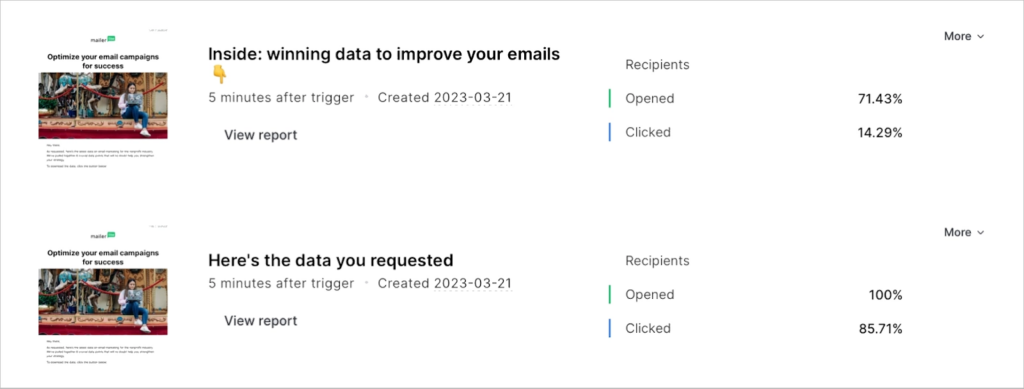
Tomer Dean: UGC E-Commerce
Tomer Dean explored whether user-generated content (UGC) or stock photos worked better for their e-commerce strategy. They ran lots of tests, mostly on fashion items, comparing real people to professionally-shot stock pics.
For example, one comparison paired a Nike sports bra stock pic to one from Instagram. The A/B test results? The Instagram pic had way more people buying—0.90% compared to just 0.31% with the stock pic. They tried the same with a Zara skirt and Nike shoes with mixed results. But when they mixed a stock pic of red high heels with three user pics on a landing page, sales went way up.
These tests showed that UGC can boost sales. And get this: e-commerce sites make about $3 per visitor, but with successful tests like these, that number can jump up by 50%!

Common A/B Testing Mistakes To Avoid
To help you make the biggest impact for effort, take my advice and avoid:
- Testing too many variables at once: Limit the number of changes between variants to accurately isolate the impact of each modification.
- Ignoring statistical significance: Ensure that your sample size is sufficient and that results are statistically significant before drawing conclusions.
- Testing unbalanced traffic or for an incorrect duration: Maintain consistency in traffic distribution between variants and run tests for an appropriate duration to account for variations in traffic patterns.
Join For More Great Marketing Insights
A/B testing is a vital tool for marketers, enabling data-driven decisions and continuous improvement. From tweaking CTAs to refining landing pages and email campaigns, it offers invaluable insights for optimizing strategies.
If you found this article helpful, share it to your network on LinkedIn and don’t forget to subscribe to The CMO newsletter for more great marketing tips!


